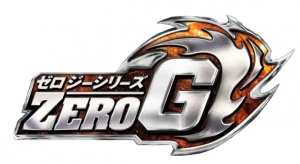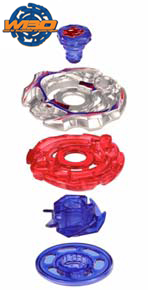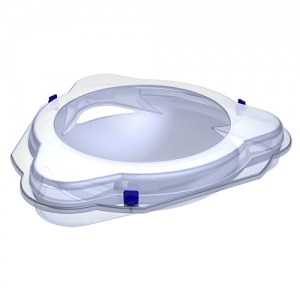Difference between revisions of "Beyblade Zero-G"
(→Components of Zero-G) |
(→Components of Zero-G) |
||
| Line 10: | Line 10: | ||
[[Image: ZeroGBeybladeParts1.jpg|thumb| Zero-G Beyblade Parts Schema]] | [[Image: ZeroGBeybladeParts1.jpg|thumb| Zero-G Beyblade Parts Schema]] | ||
Like with Metal Fight Beyblades, the components of Zero-G Beyblades are: | Like with Metal Fight Beyblades, the components of Zero-G Beyblades are: | ||
| − | *'''Stone Face:''' Unlike the MFB Faces, Zero-G Faces are diamond-shaped. They connect all the parts of a Beyblade together by screwing into the Track. There are also metal Faces called ''Metal Stone Face'' | + | *'''Stone Face:''' Unlike the MFB Faces, Zero-G Faces are diamond-shaped. They connect all the parts of a Beyblade together by screwing into the Track. There are also metal Faces called ''Metal Stone Face''. Stone Faces are approximately 1cm longer than regular MFB Faces, probably to accomodate the Synchrom system. |
*'''Chrome Wheel:''' Instead of having a plastic ring on top of the Beyblade in order to prevent launcher prongs breakage, the first layer of Zero-G Beyblades is a Chrome Wheel with considerably detailed designs. This is helped by the voluntary decision made by TAKARA-TOMY to design Chrome Wheels that are asymmetrical. One side has fewer interesting details but has a big hole for the "crystal", and the complete rest of the side is free to have all the physical features it wants without being symmetrical. | *'''Chrome Wheel:''' Instead of having a plastic ring on top of the Beyblade in order to prevent launcher prongs breakage, the first layer of Zero-G Beyblades is a Chrome Wheel with considerably detailed designs. This is helped by the voluntary decision made by TAKARA-TOMY to design Chrome Wheels that are asymmetrical. One side has fewer interesting details but has a big hole for the "crystal", and the complete rest of the side is free to have all the physical features it wants without being symmetrical. | ||
*'''Crystal Wheel:''' It is a plastic part that goes underneath the Chrome Wheel, but it can also be flipped and placed on top of the Chrome Wheel in a mode change, or not even flipped. These two modes are called ''Chrome Up Mode'' and ''Crystal Up Mode''. Seeing as it barely protrudes from the sides of the latter part, the plastic piece mostly serves aesthetic purposes in the normal mode, notably by filling the hole in the Chrome Wheel and forming the "crystal". | *'''Crystal Wheel:''' It is a plastic part that goes underneath the Chrome Wheel, but it can also be flipped and placed on top of the Chrome Wheel in a mode change, or not even flipped. These two modes are called ''Chrome Up Mode'' and ''Crystal Up Mode''. Seeing as it barely protrudes from the sides of the latter part, the plastic piece mostly serves aesthetic purposes in the normal mode, notably by filling the hole in the Chrome Wheel and forming the "crystal". | ||
Revision as of 03:12, 25 March 2012
Unofficially called "Metal Fight Beyblade Zero-G", Beyblade Zero-G is a whole new series. It is associated to Metal Fight because of similarities in the Beyblade structures as well as because the Zero-G anime and manga take place in the same universe as Metal Fight Beyblade, but this new series marks the end of Beyblade as it's been known up until now. Indeed, the main distinctive point of Beyblade Zero-G is its innovative Stadiums, but some parts were also altered to be unique to this series. These elements will be elaborated in this article.
Beyblade Zero-G's official release date is March 31st 2012 for TAKARA-TOMY, with its accompanying anime starting on April 8th 2012. This series' goal is to provide a completely fresh gameplay to Beyblades.
Contents
Components of Zero-G
Like with Metal Fight Beyblades, the components of Zero-G Beyblades are:
- Stone Face: Unlike the MFB Faces, Zero-G Faces are diamond-shaped. They connect all the parts of a Beyblade together by screwing into the Track. There are also metal Faces called Metal Stone Face. Stone Faces are approximately 1cm longer than regular MFB Faces, probably to accomodate the Synchrom system.
- Chrome Wheel: Instead of having a plastic ring on top of the Beyblade in order to prevent launcher prongs breakage, the first layer of Zero-G Beyblades is a Chrome Wheel with considerably detailed designs. This is helped by the voluntary decision made by TAKARA-TOMY to design Chrome Wheels that are asymmetrical. One side has fewer interesting details but has a big hole for the "crystal", and the complete rest of the side is free to have all the physical features it wants without being symmetrical.
- Crystal Wheel: It is a plastic part that goes underneath the Chrome Wheel, but it can also be flipped and placed on top of the Chrome Wheel in a mode change, or not even flipped. These two modes are called Chrome Up Mode and Crystal Up Mode. Seeing as it barely protrudes from the sides of the latter part, the plastic piece mostly serves aesthetic purposes in the normal mode, notably by filling the hole in the Chrome Wheel and forming the "crystal".
- Track/Spin Track: The Track is the component of the Beyblade that connects the Wheel and Bottom. The Track determines the height of the Beyblade. Their names (when read with a decimal before the last digit) determine their height in millimeters. For example, Pegasis' Track is called 105, which stands for 10.5 MM. Some Tracks have gimmicks which help make multiple good customizations since some of them are significantly heavier than others, like Flame Sagittario’s C145 Track.
- Bottom/Performance Tip: The bottom of the Beyblade. It has interchangeable tips which the Beyblade spins on. Movement patterns can be altered with the differently shaped tips that can be used. It is similar to the Blade Base from plastic Beyblades or the Running Core from HMS. The Bottom is indicated by the (sometimes two) last letter(s) of a Beyblade’s name: for instance, Capricorne 100HF, where HF is the Bottom and stands for Hole Flat. Some Zero-G Bottoms incorporate wider elements such as a big plastic ring around them, in CF's case, to help stabilise the Beyblade in these new swaying stadiums.
Synchrom
Although not yet known as a "system", it is a new element in the Metal Fight Beyblade toyline and it certainly introduces considerably more customizability. Synchrom consists of the capacity to combine one Chrome Wheel with a second Chrome Wheel to form a double, metal ring. As such, it is possible to create Salamander Ifraid as the combination of the Salamander Chrome Wheel and the Ifraid Chrome Wheel, without any need of a Crystal Wheel anywhere. Each Chrome Wheel has a round tab on its underside, and this protrusion fills the hole in the other Chrome Wheel where the crystal is supposed to fit, and vice versa.
It is speculated that, if not all Chrome Wheels are compatible to be combined with another for a Synchrom-system Wheel, at least all Boosters known as Synchrom Boosters should be able to fit the requirements.
New Zero-G Stadiums
The particularity of this new series is its stadiums, which appear to all sway. Instead of having a firm base on the ground, the only part of the Zero-G Stadium that touches the ground is the very bottom of the bowl shape. Because of this lack of stabilizers on the sides, this shape allows the Zero-G Stadiums to sway from side to side, on all sides, following the rotation of the Beyblades battling inside it. This is a true revolution in Beyblade.
Unlike all of Takara/TAKARA-TOMY's previous BeyStadiums, knock outs are not achieved in an upward direction. Instead, there are three holes at the base part of the stadium, equidistant from each other, and shaped like elongated, smoothed triangles.
Because of these two attributes, there are now 3 ways to knock out opponents:
- 1: Attack them while right next to an exit;
- 2: Make the stadium tilt to send the opposing Beyblade moving right into an exit just by the force of the launch, literally swiping the floor under its feet;
- 3: Quickly bring the top at the top of the stadium into an exit.
An official video demonstration of the Zero-G Stadium Attack Type by TAKARA-TOMY
The Zero-G Stadiums have two components:
- The main, bowl part at the bottom which contains the holes;
- The cover, which has a wide hole in its center to allow the Beyblades to be launched inside the stadium.
Those two parts are put together by three plastic clips.
Types
The same four types from Metal Fight Beyblade can be found in Beyblade Zero-G:
However, Defense Bottoms such as WD are now considered by TAKARA-TOMY Stamina Bottoms, and Defense Bottoms, for the company, are now incarnated by Sharp tips. This reflects the important change of gameplay Beyblade Zero-G introduces, where stability is always challenged.
Size
Zero-G Beyblades should be as big as Metal Fight Beyblades, especially considering the huge variety in size the latter had. Since Tracks and Bottoms are cross-compatible though, Zero-G Beyblades cannot differ too much in size.
Shooters
Where in Metal Fight Beyblade the smallest launcher possible was the Light Launcher, Zero-G still pushes the concept further. There are now Zero-G Compact Launchers available in Starters and Sets. These Compact Launchers are quite small, and they seem to incorporate the Tool used to assemble Beyblades into their design, mostly at the top. They can only be used with the newest Winders in Metal Fight Beyblade, which appeared with the release of the Sniper Launcher.
Zero-G Light Launchers also exist, and they are meant to have 1.1 more revolutions than Zero-G Compact Launchers. These can be bought separately from Starters.
For the moment, no Zero-G Beyblades spin left, so there are no left launchers known.
Conclusion
While it is completely new and generally untested, Beyblade Zero-G offers the freshness Beyblade needed to avoid going into a second hiatus, as it did after Bakuten Shoot Beyblade. This series will introduce the development of multiple new launching techniques and strategies, and invariably display Beyblade battles like never seen before.


